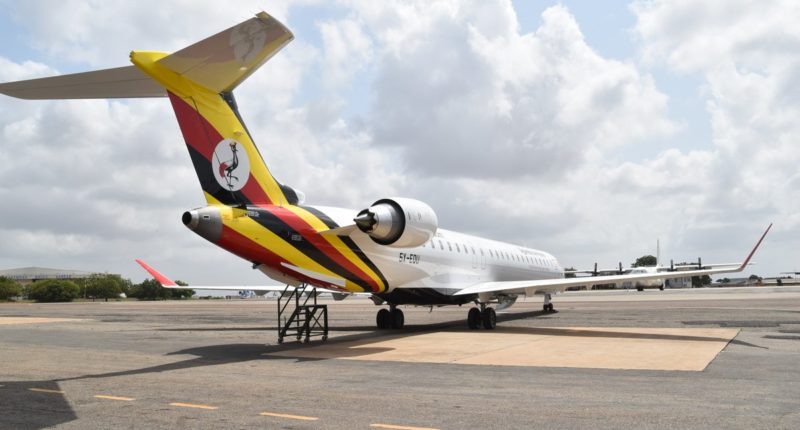Two Bombardier CRJ900 jets descended from the skies on the morning of Monday 23, April 2019, landing at Entebbe International Airport to mark a momentous feat in the process of reviving the country’s national carrier, Uganda Airlines.
The jets touched down at the airport runway to ululations and rhythms of dancing troupes. Uganda’s President, Yoweri Museveni and First Lady, Janet Kataha were among the hundreds of dignitaries and excited citizens who welcomed the new aircraft.
The jets are part of a grand plan to acquire 6 aircraft, 4 bombardiers and 2 Airbus A330-800, worth UGX. 1.20 trillion ($319 million) required to revive the national carrier that last flew in 2001, in part, thanks to a turbulent history of chronic mismanagement and under-financing.
In the late 1990s, the defunct Uganda Airlines was in a delicate cash position owing to mismanagement. Uganda sought to privatize the debt-ridden airline hoping that an investor would keep the company afloat and the Crane flying. Initially, several firms expressed interest in taking over Uganda Airlines. However, the interest never seemed to materialize into an acquisition and government liquidated the airline in May 2001.
Its revival triggers nostalgia of the company’s past successes and challenges. This past history offers invaluable lessons as the national carrier ascends to the skies again.
Mr. Zephaniah Mugere Baliwada, a retired aviation expert witnessed Uganda Airlines’ collapse and is euphoric about the national carrier’s revival. “It’s a good thing to revive the airline. Competition is necessary in this world.”
Baliwada was a regional representative, Eastern and Southern African Office at the International Civil Aviation Organization (ICAO) in the 1990s when government sought to save the carrier. Uganda turned to ICAO for advice. “I was in ICAO when we commissioned a mission to Uganda to work out the future of the airline. We recommended that Uganda airlines merge with a bigger airline but that recommendation was not carried forward. And as a result the airline collapsed,” he recollects.
“Reviving it is a good thing but costly,” he says, warning that close cooperation will be key for survival of regional carriers. “Survival in the airline industry depends on cooperation with other airlines as it is in North America and Europe. Africans must learn to work together.”
“I was among those who buried the old airline and I am among the midwives delivering the new baby. This new baby will never die,” President Museveni vowed as he officially received the jets.
Museveni remarked that the revival of Uganda Airlines sets a new dawn for the country and is poised to open access to key regional markets. He argued that Uganda will use the airline to market the country as a top tourism destination in the region and globally.
How Uganda Airlines plans to gain a piece of the regional aviation market share, is a question that has left many tongues wagging. Already, it joins a competitive aviation market in Africa. Much remains to be seen how the national carrier will redeem its profitability in a quest to build a continental brand which out-muscles established and reputable carriers like Ethiopian Airways, Kenya Airways, South Africa Airways, among others.
Uganda is following the footsteps of countries like Ghana, Mali, Senegal, Zimbabwe, Zambia, Cote d’Ivoire and Tanzania that have entered the airline business in the past five years.
Mathematics of optimism
The Uganda Airlines is a project based on economic assumptions of a brighter future. Of course assumptions drive conception of any project, but when real numbers start tickling in, they will lay bare hopes and surrealism that drove Uganda Airlines’ revival.
In addition to the UGX. 1.2 trillion prce tag for planes purchase, government will inject UGX. 260 billion ($70M) as capitalisation and working capital fund in the first five years. The company is expected to record profits of $3.9M and $7.2M respectively in the first and second years of operating regional flights. The company is also expected to register $6.1M loss in the third year with introduction of international routes. But it is expected to quickly recover in the fourth year by recording $2.4M profit and a record profit of $11.9M in the fifth year.
Regarding flights and passenger traffic, it is anticipated that based of 15 chosen regional routes, annual hours of flights will be 13,716 giving 3,429 hours per aircraft per annum and averaging at 10 hours per day. The international routes–starting 2021 after receipt of the A330neos–will operate a total of 10,269 hours annually. This is an average of 5,134 hours per aircraft per annum translating to 14.5 hours per day.
Regional flights will offer 639,600 seats and international routes 374,192 seats per annum. This totals to 1,013,792 seats per year, which is nearly 64% of the 2016 Uganda market demand. Passenger traffic is estimated at 396,000 for regional flights in the first year–slightly above half of the seats. But this traffic will increase to 529,000 by the fifth year. And on long haul flights, passenger traffic is projected at 251,000 in 2021 growing to 293,000 passengers in 2022.
Flight fares are projected to be as low as $136 for a one way ticket economy class and $320 business class for Entebbe-Jomo Kenyatta International Airport. These figures are laid in the National Airlines Business and Implementation Plan, a 2017 document that ticked revival of the carrier.
Is this assumption of optimism feasible in an industry where nearly all established carriers have been recording losses for years? East African skies giant–Kenya Airways released its 2018 annual report at the end of April, announcing a $75M loss. Veteran Uganda aviation journalist, Michael Wakabi says it’s important for Uganda Airline to discern why regional carriers are making losses and tread carefully. He says regional carriers are making losses for different reasons.
Kenya Airways, Wakabi says, is making losses while its younger low cost subsidiary–Jambojet–is in profit. “Why? Kenya Airways has historical debt from some bad decisions about expansion made around 2011. The airline was saddled with aircraft it did not need that were bought at abnormally high prices.”
Rwandair, Wakabi says is making minimal losses but is capitalised at the operational level. “Their loss position is as result of getting new aircraft to support growth. This year they are taking another two A330’s. That pushes break even further out.”
The key takeaway for Uganda Airline, he says, is to carefully analyse the Kenya Airways and RwandAir situation and act differently. “So what can Uganda Airlines do differently? By watching their unit cost and matching capacity to the market. So far they have done well with the fleet choice. Secondly they need to make sure that they are well capitalized to meet their obligations.”
Long term vision
The national carrier comes on the heel of other infrastructure gigantic projects that government has undertaken in the past decades. Dr. Joseph Muvawala, the executive director of the National Planning Authority says the airline is in line with Uganda’s Vision 2040 that sets the long-term aspirations of transforming Uganda from predominantly peasant to a modern and prosperous country within 30 years.
The idea was formulated in the first and second National Development Plans (NDPs) where the airline is highlighted as one of the key flagship projects expected to propel Uganda towards medium and long-term development goals. “The decision to revive the airline was based on Uganda’s past aviation experience, as well as lessons from the success and failure of airlines globally,” Muvawala says.
Integrating Emerging Markets
Uganda seeks to tap into Africa’s air transport market which has an estimated 88.5 million annual air travelers according to the International Air Transport Association (IATA) data. Analysis of the Uganda air travel market shows that the largest demand for air travel is within Africa destinations–largely East and Central Africa.
IATA says by 2035, Africa air traffic is projected to increase by almost four folds to 303 million. Uganda will be among countries driving this growth.
The top ten fastest-growing markets will be: Sierra Leone, Guinea, Central African Republic, Benin, Mali, Rwanda, Togo, Uganda, Zambia and Madagascar. Projections show that each of these markets is expected to grow by more than 8% annually on average over the next 20 years, doubling in size every decade. The Africa air travel market will in the coming years, therefore be a potential source of economies of scale for new airlines such as Uganda’s national carrier.
Africa Development Bank (AfDB) President, Akinwumi Adesina has for years been reckoning that Africa needs to grow and integrate with itself. The air transport sector provides an opportunity for growth and integration actualization.
The ongoing liberalization process of the civil aviation industry in Africa, as an impetus to the Continent’s economic integration agenda, led to the launch of the Single African Air Transport Market (SAATM), a flagship project of the African Union Agenda 2063, The Open Skies agreement, originally signed by 23 out of 55 Member States, aims at creating a single unified air transport market in Africa.
Many air transport markets worldwide have de-regularized, leading to increased growth and development. Africa, however, has yet to fully liberalize its intra-African market, relying more on restrictive bilateral air service agreements that impedes economic growth and development.
Data from IATA reveals that Africa is home to 16% of the world’s population but it accounts for only 2.20% of the global air service market. With a clear need for air travel and a demand for more quality airlines, the African continent is emerging from under the radar and making gains to increase its total market share.
Uganda Airlines is thus anticipated to push up competition for regional flights, slicing a percent of the pie which has for long been dominated by carriers such as Kenya and Ethiopian Airways.
As such, the four jet fleet of CRJ900s is projected to address a regional market thirst. This will enhance connectivity, stimulate traffic growth, and develop the interconnecting hub at Entebbe airport.
The main regional destinations for traffic are: Nairobi–the largest market–followed by Kilimanjaro, Kigali, Johannesburg and Juba. Uganda is also targeting previously unserved markets such as Khartoum, Mogadishu, Kinshasa, Lubumbashi, Goma, Mombasa, Lagos and Accra, where connectivity to Uganda requires at least one intermediate stop in both directions.
Starting at home
The national carrier anticipates to facilitate growth of the sector by providing the necessary connectivity for business people and the public crisscrossing the region. Cornwell Muleya, the technical advisor to the Presidential National Airline Implementation Taskforce, explains that for any airline to succeed, it must be in control of the home market.
“The first step in any business is finding the market that you have locally and regionally. Once you build on that market, then you can try elsewhere,” Muleya says. “We are, therefore, starting to build a structure that allows to consolidate traffic through Entebbe. The idea is that we start with the regional routes for at least two years and after that, we will go international.”
Uganda’s population of more than 40 million people offers a good market base with passenger growth at Entebbe averaging about 6 percent annually for the last 5 years. Out of the 1.5 million passengers in 2014, 60% were Ugandans, government officials being the largest traveler.
More than 50,000 metric tons of cargo flew out of Uganda destined to COMESA, Europe, and Middle East and Asia in 2014. The national carrier targets to grab a pie of this cargo business.









